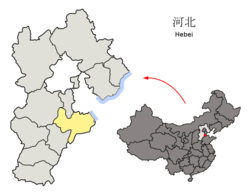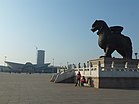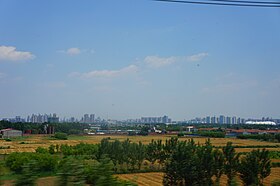Cangzhou
Cangzhou
沧州市 Tsangchow | |
|---|---|
Clockwise from the top: Iron Lion, Cangzhou Arena, Skyline of Cangzhou, Port of Huanghua, Arcadia Hotel | |
| Nickname: Lion City (狮城) | |
 | |
 Location of Cangzhou City jurisdiction in Hebei | |
| Coordinates (Cangzhou municipal government): 38°18′17″N 116°50′19″E / 38.3047°N 116.8387°E | |
| Country | People's Republic of China |
| Province | Hebei |
| Settled | 517 |
| Established | 15 November 1983 |
| Municipal seat | Yunhe District |
| Area | |
| 14,383.46 km2 (5,553.48 sq mi) | |
| • Urban | 206.2 km2 (79.6 sq mi) |
| • Metro | 1,750.7 km2 (675.9 sq mi) |
| Elevation | 13 m (42 ft) |
| Population (2020 census)[1] | |
| 7,300,783 | |
| • Density | 510/km2 (1,300/sq mi) |
| • Urban | 795,832 |
| • Urban density | 3,900/km2 (10,000/sq mi) |
| • Metro | 1,421,843 |
| • Metro density | 810/km2 (2,100/sq mi) |
| GDP[2] | |
| • Prefecture-level city | CN¥ 332 billion US$ 53.3 billion |
| • Per capita | CN¥ 44,819 US$7,196 |
| Time zone | UTC+8 (China Standard) |
| Postal code | 061000 |
| Area code | 0317 |
| ISO 3166 code | CN-HE-09 |
| Licence plate prefixes | 2022 |
| Website | cangzhou.gov.cn |
| Cangzhou | |||||||||
|---|---|---|---|---|---|---|---|---|---|
| Simplified Chinese | 沧州 | ||||||||
| Traditional Chinese | 滄州 | ||||||||
| Postal | Tsangchow | ||||||||
| Literal meaning | "oceanside prefecture" | ||||||||
| |||||||||
Cangzhou[a] is a prefecture-level city in eastern Hebei province, People's Republic of China. At the 2020 census, Cangzhou's built-up (or metro) area made of Yunhe, Xinhua districts and Cang County largely being conurbated had a population of 1,421,843 inhabitants, while the prefecture-level administrative unit in total has a population of 7,300,783. It lies approximately 90 kilometres (56 mi) from the major port city of Tianjin, and 180 km (110 mi) from Beijing.
History
[edit]This section needs expansion. You can help by adding to it. (July 2012) |
Cangzhou is reported to have been founded in the Southern and Northern Dynasties period (420−589 CE).
Administrative divisions
[edit]Cangzhou City comprises 2 districts, 4 county-level cities, 9 counties and 1 autonomous county.
| Map | ||||||
|---|---|---|---|---|---|---|
| Name | Hanzi | Hanyu Pinyin | Population (2020)[3] |
Area (km2) | Density (/km2) | |
| Yunhe District | 运河区 | Yùnhé Qū | 511,086 | 138 | 1,957 | |
| Xinhua District | 新华区 | Xīnhuá Qū | 284,746 | 89 | 2,472 | |
| Botou City | 泊头市 | Bótóu Shì | 573,842 | 977 | 563 | |
| Renqiu City | 任丘市 | Rénqiū Shì | 816,401 | 1,023 | 753 | |
| Huanghua City | 黄骅市 | Huánghuá Shì | 652,401 | 1,545 | 317 | |
| Hejian City | 河间市 | Héjiān Shì | 795,198 | 1,333 | 578 | |
| Cang County | 沧县 | Cāng Xiàn | 626,011 | 1,527 | 432 | |
| Qing County | 青县 | Qīng Xiàn | 420,878 | 968 | 403 | |
| Dongguang County | 东光县 | Dōngguāng Xiàn | 340,288 | 710 | 493 | |
| Haixing County | 海兴县 | Hǎixīng Xiàn | 189,273 | 836 | 263 | |
| Yanshan County | 盐山县 | Yánshān Xiàn | 411,356 | 795 | 503 | |
| Suning County | 肃宁县 | Sùníng Xiàn | 341,919 | 497 | 664 | |
| Nanpi County | 南皮县 | Nánpí Xiàn | 347,473 | 794 | 441 | |
| Wuqiao County | 吴桥县 | Wúqiáo Xiàn | 217,986 | 603 | 464 | |
| Xian County | 献县 | Xìàn Xiàn | 568,418 | 1,191 | 479 | |
| Mengcun Hui Autonomous County | 孟村回族自治县 | Mèngcūn Huízú Zìzhìxiàn |
203,507 | 393 | 458 | |
Economics
[edit]Cangzhou's urban center is a heavily industrial city, but the city's administrative territory also includes strongly agricultural areas, and is well known in China for its Chinese jujubes (Chinese dates), apples and pear (widely known under the export name of Tianjin Ya Pear). The North China Oil Field is within Cangzhou City's jurisdiction. Cangzhou also encompasses a large fishing port and the coal-exporting Huanghua Harbour. Notable International Companies located in Cangzhou Hyundai (Japan), Hage Fittings und Flanschen GmbH (Germany) (Hage Fluid Control Technology (Hebei) Co., Ltd Joint Venture).
Geography and transportation
[edit]
Cangzhou is located in eastern Hebei, immediately to the south of Tianjin, near the coast of the Bohai Sea of the Pacific Ocean. Bordering prefecture-level cities are Hengshui to the southwest, Baoding to the west, and Langfang to the north. It lies on the Beijing–Shanghai Railway.
The G1811 Huanghua–Shijiazhuang Expressway connects Cangzhou to Shijiazhuang, the provincial capital, and is linked to Beijing via both the G2 Beijing–Shanghai Expressway and G3 Beijing–Taipei Expressway, which are concurrent within the province, and to Shanghai via G2. Cangzhou's Huanghua Harbour is the end of a main Chinese coal shipping railway, the Shuohuang Railway. Other major highways serving Cangzhou's urban area are China National Highway 104 and 307.
Major airports located closest to Cangzhou include Beijing Capital Airport and Tianjin Airport.
The Grand Canal passes directly through Cangzhou, and a district of Cangzhou (Yunhe District) is named after it.
Climate
[edit]Cangzhou has a four-season, monsoon-influenced humid continental climate/semi-arid climate (Köppen BSk/Dwa), with cold, dry winters, and hot, humid summers. The monthly 24-hour average temperature ranges from −3.2 °C (26.2 °F) in January to 27.2 °C (81.0 °F) in July, while the annual mean is 13.25 °C (55.8 °F). A majority of the annual precipitation of 541 mm (21.3 in) occurs in July and August alone. With possible monthly percent possible sunshine ranging from 49% in July to 65% in October, the city receives 2,663 hours of bright sunshine annually.
| Climate data for Cangzhou (1991–2020 normals) | |||||||||||||
|---|---|---|---|---|---|---|---|---|---|---|---|---|---|
| Month | Jan | Feb | Mar | Apr | May | Jun | Jul | Aug | Sep | Oct | Nov | Dec | Year |
| Record high °C (°F) | 15.1 (59.2) |
18.7 (65.7) |
30.9 (87.6) |
32.7 (90.9) |
37.7 (99.9) |
40.3 (104.5) |
42.0 (107.6) |
36.6 (97.9) |
35.0 (95.0) |
30.4 (86.7) |
24.2 (75.6) |
14.6 (58.3) |
42.0 (107.6) |
| Mean daily maximum °C (°F) | 2.9 (37.2) |
6.9 (44.4) |
14.0 (57.2) |
21.5 (70.7) |
27.4 (81.3) |
31.7 (89.1) |
32.4 (90.3) |
30.8 (87.4) |
27.2 (81.0) |
20.6 (69.1) |
11.5 (52.7) |
4.4 (39.9) |
19.3 (66.7) |
| Daily mean °C (°F) | −2.8 (27.0) |
1.0 (33.8) |
7.7 (45.9) |
15.0 (59.0) |
21.2 (70.2) |
25.7 (78.3) |
27.5 (81.5) |
26 (79) |
21.4 (70.5) |
14.5 (58.1) |
5.9 (42.6) |
−0.9 (30.4) |
13.5 (56.4) |
| Mean daily minimum °C (°F) | −7.1 (19.2) |
−3.7 (25.3) |
2.3 (36.1) |
9.3 (48.7) |
15.2 (59.4) |
20.3 (68.5) |
23.2 (73.8) |
21.9 (71.4) |
16.5 (61.7) |
9.3 (48.7) |
1.3 (34.3) |
−5.0 (23.0) |
8.6 (47.5) |
| Record low °C (°F) | −22.1 (−7.8) |
−14.6 (5.7) |
−11.3 (11.7) |
−1.2 (29.8) |
5.1 (41.2) |
12.5 (54.5) |
17.1 (62.8) |
14.1 (57.4) |
6.8 (44.2) |
−2.3 (27.9) |
−8.3 (17.1) |
−20.3 (−4.5) |
−22.1 (−7.8) |
| Average precipitation mm (inches) | 2.4 (0.09) |
7.5 (0.30) |
8.7 (0.34) |
22.8 (0.90) |
35.9 (1.41) |
71.4 (2.81) |
153.5 (6.04) |
126.5 (4.98) |
49.5 (1.95) |
36.2 (1.43) |
16.0 (0.63) |
3.0 (0.12) |
533.4 (21) |
| Average precipitation days (≥ 0.1 mm) | 1.6 | 2.5 | 2.9 | 4.8 | 5.7 | 8.1 | 11.5 | 9.5 | 5.6 | 4.7 | 3.7 | 1.9 | 62.5 |
| Average snowy days | 2.5 | 2.1 | 0.8 | 0.2 | 0 | 0 | 0 | 0 | 0 | 0 | 1.0 | 1.6 | 8.2 |
| Average relative humidity (%) | 57 | 53 | 48 | 50 | 54 | 59 | 73 | 77 | 69 | 64 | 64 | 60 | 61 |
| Mean monthly sunshine hours | 174.4 | 182.3 | 234.3 | 253.1 | 279.5 | 247.6 | 215.2 | 215.3 | 220.5 | 209.5 | 172.3 | 165.7 | 2,569.7 |
| Percent possible sunshine | 57 | 59 | 63 | 64 | 63 | 56 | 48 | 52 | 60 | 61 | 57 | 56 | 58 |
| Source: China Meteorological Administration[4][5][6] | |||||||||||||
Culture
[edit]
The city has historically been known in China for its wushu (Chinese martial arts) and acrobatics (specifically, the Wu Qiao school). Cangzhou is also famed for its historic thousand-year-old 40-ton sculpture, the Iron Lion of Cangzhou. The sculpture is reportedly the largest cast-iron sculpture in the world, cast in 953 in the Five Dynasties and Ten Kingdoms period. The famed lion has even given its name to a locally brewed beer (iron lion beer, 铁狮啤酒) and is a symbol of the city.[7]
Cangzhou is home to a traditional Chinese form of musical performing arts, Kuaiban Dagu.
The city hosts seven mosques for Muslim adherents (mostly Hui).[8] One of them, the West Mosque, has collected at its museum one of China's best collections of Islamic manuscripts and artefacts.[9]
Demographics and society
[edit]Cangzhou, though predominated by the Han Chinese majority, is home to a sizable population of the Muslim Hui minority. Intermarriage occasionally occurs between the majority Han and the Hui, but stereotypes of Hui still exist among Cangzhou's Han residents, and some tensions remain. Migration to Hebei province and Cangzhou by Xinjiang Muslim minorities (generally ethnic Uighurs) is increasing.[citation needed]
Language
[edit]The dominant first language of Cangzhou's population is a variety of the northeastern Mandarin dialect continuum termed Cangzhou,[10] which is a variety of Ji Lu Mandarin. There are some similarities with the Tianjin variety and the Baoding variety of Mandarin, but both are considered distinct groups from that of Cangzhou [1]. Dialects of the Cangzhou area vary between localities and counties, though are generally intelligible among each other.
Municipal government
[edit]The city, like all other Chinese administrative divisions, has a party committee, the People's government, the People's Congress, and the Political consultative conference.
Military
[edit]Cangzhou is home to the Cangzhou Airbase of the People's Liberation Army Air Force
Sports
[edit]Shijiazhuang Ever Bright moved to Cangzhou and changed their name to Cangzhou Mighty Lions, they play at the Cangzhou Stadium.
Education
[edit]Cangzhou Normal University (沧州师范学院): now it has 871 teacher staff, including 607 full-time teachers, 233 people with the title of deputy senior or above, and 405 people with master's and doctor's degrees. The school motto is "knowing, morality, knowledge and behaviour, innovation" (明德、博学、知行、日新).
This section needs expansion. You can help by adding to it. (August 2015) |
There is one international school in Cangzhou, the Cangzhou Zhenhua Korean International School (沧州振华韩国国际学校).[11]
Notable residents
[edit]- Sun Yue (1985), fifth Chinese national to play in the NBA
- Wang Zi-Ping (1881–1973), Chinese martial arts grandmaster
- Jia Qinglin (1940), former member of Politburo Standing Committee and Chairman of CPPCC
- Zhang Lichang (1939–2008), former member of Politburo and Party Secretary of Tianjin.
Notes
[edit]References
[edit]- ^ "China: Hébĕi (Prefectures, Cities, Districts and Counties) – Population Statistics, Charts and Map".
- ^ 河北省统计局、国家统计局河北调查总队. 《河北经济年鉴-2018》. China Statistics Press. ISBN 978-7-5356-7824-9. Archived from the original on 26 March 2020. Retrieved 11 July 2019.
- ^ "China: Hébĕi (Prefectures, Cities, Districts and Counties) - Population Statistics, Charts and Map". www.citypopulation.de. Retrieved 31 October 2024.
- ^ 中国气象数据网 – WeatherBk Data (in Simplified Chinese). China Meteorological Administration. Retrieved 26 August 2023.
- ^ "Experience Template" 中国气象数据网 (in Simplified Chinese). China Meteorological Administration. Retrieved 26 August 2023.
- ^ 中国地面国际交换站气候标准值月值数据集(1971-2000年). China Meteorological Administration. Archived from the original on 21 September 2013. Retrieved 25 May 2010.
- ^ Wagner, Donald B. "The cast iron lion of Cangzhou", Needham Research Institute newsletter, no. 10, June 1991, pp. 2-3.
- ^ Steinhardt, Nancy Shatzman (2015). China's Early Mosques. Edinburgh: Edinburgh University Press. p. 168. ISBN 978-1-4744-3721-9.
- ^ WEST MOSQUE MUSEUM, CANGZHOU, HEBEI PROVINCE CHINA HERITAGE NEWSLETTER, No. 5, March 2006. (China Heritage Project, The Australian National University. ISSN 1833-8461).
- ^ "Mandarin Jilu Canghui Huangle Chinese Dialect Classification". Archived from the original on 15 October 2006. Retrieved 27 September 2009.
- ^ "Schools Approved by the Ministry of Education For Enrolling Children of Foreign Nationals" (Archive). Ministry of Education of China. Retrieved on 17 August 2015.
- DuBois, Thomas. The Sacred Village: Social Change and Religious Life in Rural North China. Honolulu: University of Hawaii Press, 2005.
External links
[edit]- Article about the Cangzhou Lion (in Chinese)
- "Chinese 'serial killer' arrested". BBC World Service. 15 November 2003. (Incident in Cangzhou)
- https://www.hyundai.news/eu/articles/press-releases/hyundai-motor-company-opens-new-plant-in-cangzhou-china.html
- https://www.hagetek.de/










